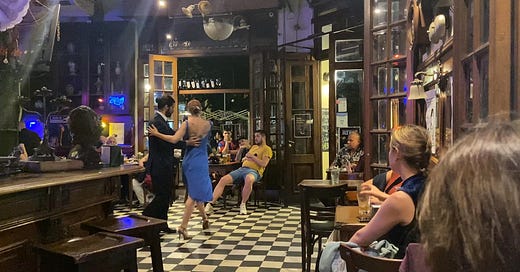“The mind was dreaming. The world was its dream.”
~ Jorge Luis Borges (1899-1986)
Joel Bowman with today’s Note From the End of the World: Buenos Aires, Argentina…
Named in honor of the patron saint of seafarers, the oldest and most storied of Argentina’s many distinct barrios, Saint Pedro González Telmo, or simply “San Telmo,” is a true portal into the city’s past.
Settled by stevedores, tanners and brick makers in the 17th century, the southern district was originally separated from the wealthier, northern suburbs of Buenos Aires proper by an imposing ravine. One imagines the stench from the slaughterhouses and squalid working conditions as something akin to the horrid scenes from Upton Sinclair’s The Jungle, set in Chicago a century and a half later.
The nearby port, which delivered Argentina’s prized goods – wool, hides, leather and later agricultural products – beyond the seas to the known world, ensured a steady flow of transient workers to these fair shores, including just the type of men who would frequent the area’s many and seedy bars and bordellos.
It was from this milieu, shadowed by dark alleys and heartache, that the famous tango music was born. Sings Francisco Lomuto in his 1932 classic, San Telmo:
San Telmo
Calles de San Telmo
Adoquines viejos
Piedras que he pisado
Al verlos conmigo
He quedado
Tragando saliva
Pa' no lagrimear
San Telmo
Streets of San Telmo
Old cobblestones
Stones that I have stepped on
I have been left
Swallowing saliva
So as not to cry…
By the mid-19th Century, conditions in San Telmo had begun to improve, with new public works – clinics, gas mains, lighting and sewers – and the ubiquitous cobblestone streets connecting residents to the central market, which sold everything from fresh produce to furniture to artisanal tapestries and textiles. It was during this era that many of the barrio’s imposing mansions were constructed as wealth began to pour into the rapidly gentrifying district.
Alas, no sooner had San Telmo’s fortunes risen than the tides turned once again, this time with the outbreak of yellow fever, in 1871. Those who could vacated the dockside quarters and decamped for the wide open spaces of the city’s north side, what are presently the well-heeled barrios of Recoleta, Palermo and Belgrano.
Today, San Telmo is famous for its museum-like antique stores, which transfer curios and treasures from the city’s past to its hopeful future, as well as the many artists and street performers, who dance the sorrowful tango on cobblestones streets and in the barrio’s timeless cafés notables, as seen in the clip above...
And now for your Notes From the End of the Week…
Final Notes…
Napoleon used to say, “Never interrupt your enemy when he’s making a mistake,” to which we would add the obvious corollary, “never interrupt your friends while they’re paying you a compliment.”
That in mind, here’s what a few dear Members have to say about their Notes experience…
A big thanks to ALL our dear Members!
It’s been about 15 months since we set sail on this little Notes project and, thanks to the generosity of our Members, we’ve been able to parlay our scribbles into something that threatens to become a full time endeavor. In fact, we’re now read in all 50 US States and across 137 countries around the world. Pretty neat, huh?
To thank our Members, we’re hosting another Notes Virtual Summit in early April. This one will be focused on Crisis and Opportunity at the End of the World. Watch this space for more details, including special guest speakers and exclusive, Member Only benefits…
Oh, and if you’re not already a Notes Member, you can correct that calamitous oversight easily enough, right here…
We’re off to wander these cobblestone streets a little while longer. Whatever you’re up to this weekend, we hope you’re enjoying your own End of the World.
Cheers,
Joel Bowman


















Share this post